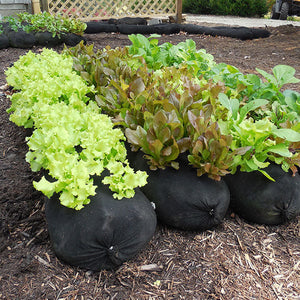For anyone learning how to grow eggplant, it may come as a surprise that this low-calorie nightshade is technically a fruit, not a vegetable. A Mediterranean favorite, eggplant is often used in vegetarian dishes to make them more satiating because of its unique texture and ability to absorb flavors.
While purple eggplants are the most common variety that is grown, green, white, orange, and variegated varieties also exist. While the fruit of the plant is versatile and delicious, the flowers and foliage should not be consumed as they contain a toxin called solanine, which can be harmful in large quantities.

Growing eggplant in GardenSoxx® | Plant Family: Solanaceae (Nightshade)
Different Varieties of Eggplant
While we may be most accustomed to the common large, dark eggplants we see in grocery stores, many different varieties of eggplants can be grown in the home garden. Here are a few that you may want to plant in your GardenSoxx:
The Shooting Stars Eggplant is a smaller variety perfect for container gardening. They grow to about 3-4” long and have a gorgeous purple and white striped coloring. The plant grows to about 30 inches tall and the fruit it produces will mature in less than 60 days.
Another small purple eggplant variety to look out for would be the Fairytale eggplant. This variety can double as an ornamental with its whimsical look and more compact growing style. Fairytale eggplants grow to about 4” long and have a delicious taste with barely any seeds.
A unique white heirloom eggplant from France, the Casper eggplant is an interesting choice for the home garden. Growing to about 6” long, with a taste and texture reminiscent of a mushroom - this eggplant grows well in northern regions and will produce a harvest in about 75 days from planting.
For something completely different, the Rossa Di Rotonda variety produces a small red eggplant that looks more like a tomato or pepper and has a sweet taste to match. This Italian, open-pollinated eggplant is an excellent option for pickling.
Previously only available through specialty growers, the Long Green eggplant is gaining more popularity in North America. This variety of Thai eggplant produces long green fruits, as the name suggests, with a mild flavor that borders on sweet.
Nutritional Information For Eggplant
Nutritional Facts - per 100/g
| Nutrient | Amount | % Daily Value |
|---|---|---|
| Calories | 25 | - |
| Total Fat | 0.2 g | - |
| Sodium | 2 mg | - |
| Potassium | 229 mg | - |
| Dietary Fiber | 6 g | - |
| Sugar | 3.5 g | - |
| Protein | 1 g | - |
| Vitamin C | - | 3% |
| Iron | - | 1% |
| Vitamin B6 | - | 5% |
| Magnesium | - | 3% |
How to Grow Eggplant in Your GardenSoxx®
Eggplant seedlings can be delicate and need a good amount of heat to grow. It is best to sow seeds indoors several weeks before the last spring frost and ensure the seedlings are properly hardened off before transferring to the soil. Plant seedlings once the risk of any frost has passed and the soil has sufficiently warmed. Eggplants will do well when planted together, as there will be increased flower pollination, potentially leading to more fruit production.
Eggplant Seed to Harvest Time: Approximately 115 days

How to Harvest Eggplant
Since eggplant size can vary quite a bit, it is not the best indicator of when to harvest. Once the skin of the eggplant becomes shiny, and the fruit is firm to the touch, they are ready to harvest. Cut the eggplant at the stem, leaving about one inch of stem on the fruit if possible - using gloves during harvest is recommended as the eggplant stems can sometimes have tiny prickly hairs that can irritate your skin.























































